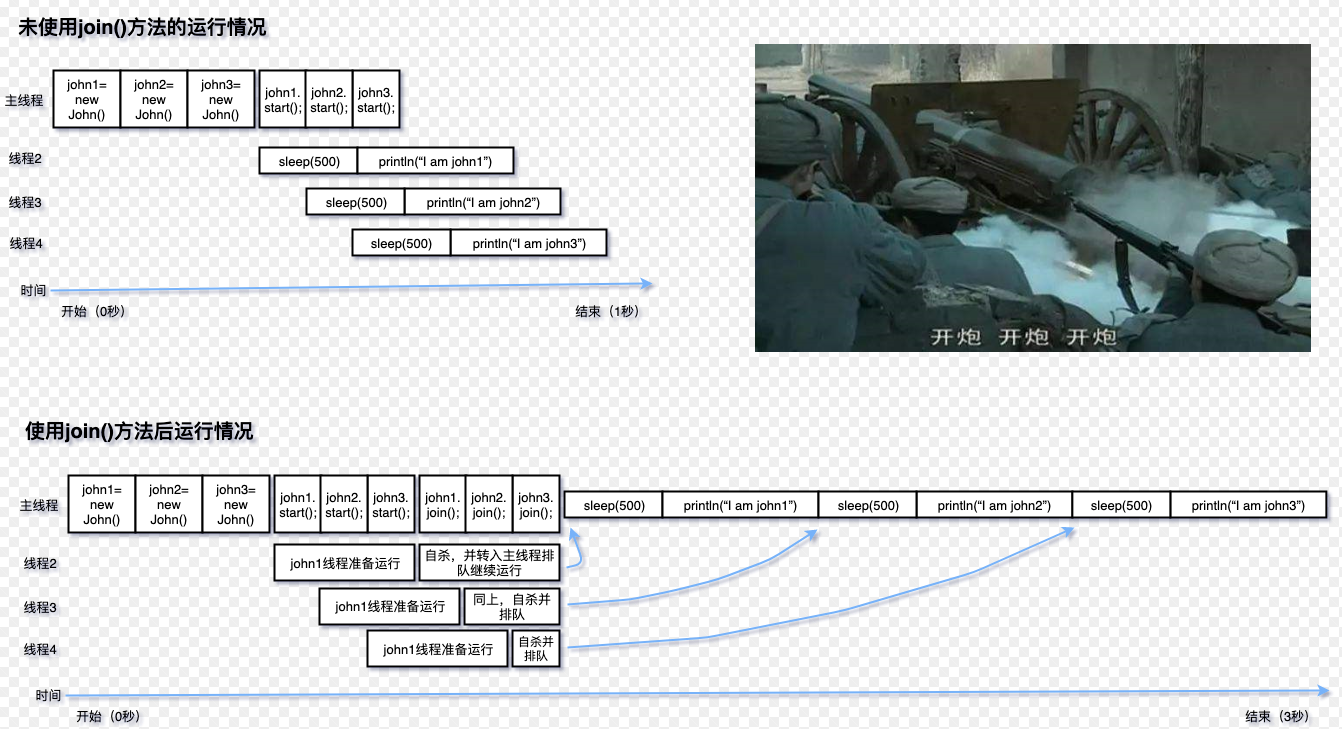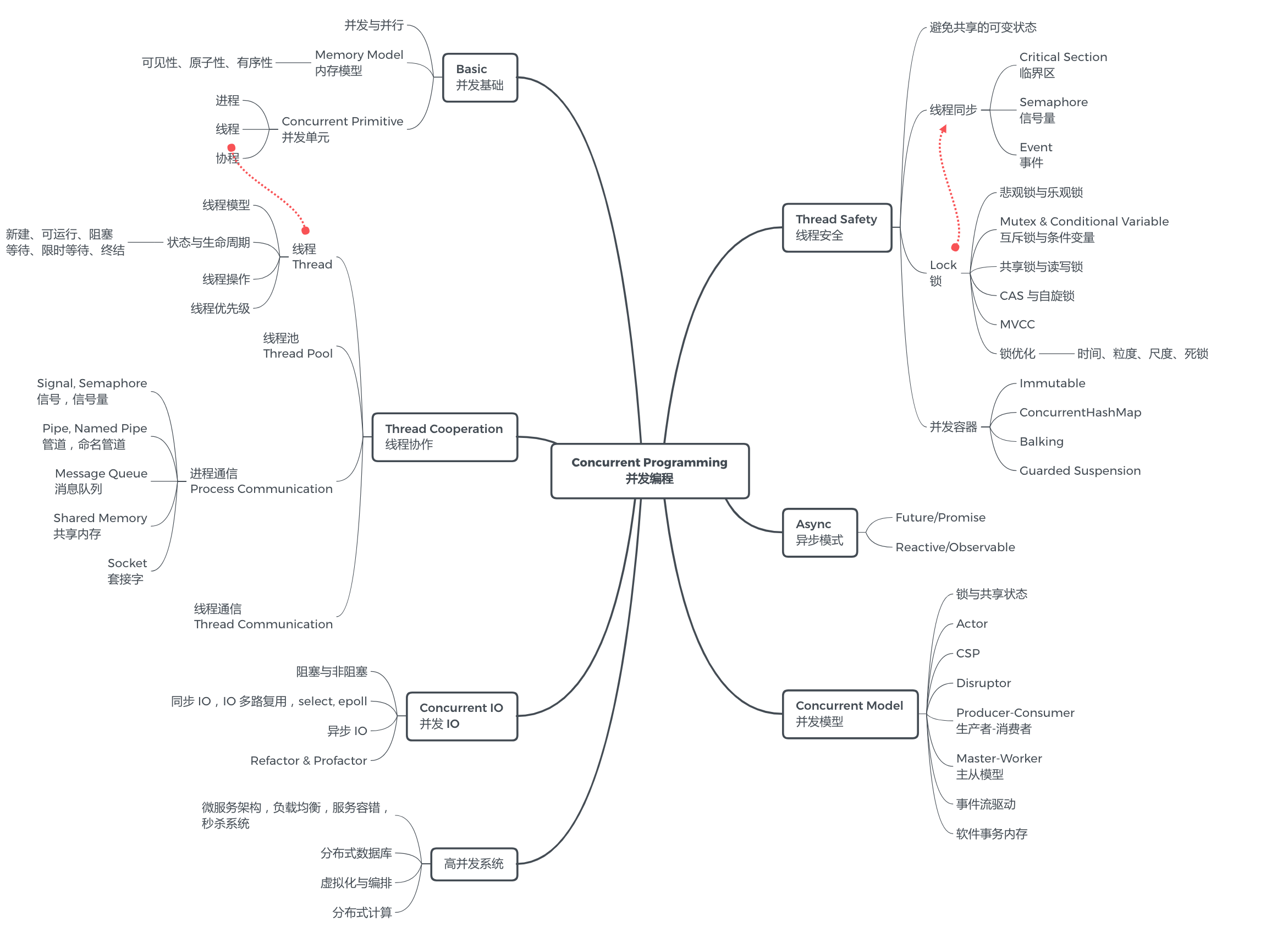
有一天我走在路上,偶尔接触到了Thread.join()方法,便到网上去查阅相关资料,但也是看得我一头雾水(花露水)。在我很久的理解之后,便想将我理解的join()方法以一张图的方式解释出来。
一、我画
开局一张图:

John线程的运行过程。
别着急,多看两遍! 我们可以看到,在主线程调用了join()方法后,指定的线程会被抓回来在后边老老实实地排队。
二、你猜
💡 问:请回答未执行join()方法和执行了join()方法的运行结果有什么不同(可能有几种结果、运行的时间、输出的顺序)?
🌱 答:
| 类型 | 可能结果数量 | 运行速度 | 输出顺序 | 时间复杂度(最好) |
|---|---|---|---|---|
| 不使用join() | 6种 | 快(多线程 | 乱序 | O(1) |
| 使用join() | 1种 | 慢(单线程) | 顺序 | O(n) |
- 看完后,你可能还会有些疑问:
💡 Q:为什么不使用join()的可能结果数量是6种?输出顺序为什么是乱序?
🌱 A:由于多线程的原因,虽然start()顺序执行了线程1/2/3,但可能由于各种原因,某个线程会抢先完成,从而造成了6种运行结果 ——
123
132
213
231
321
312
- 多线程并不老实,并且难以(ye不是不可能)控制。
💡 Q:为什么使用join()后会变慢?
🌱 A:因为使用join()后,三个线程会按顺序被赶到主线程去运行,这时候它们就不能够同时运行了,只能一个一个地运行
三、动手
别偷懒,乘还年轻,打开你的IDE,把下边的代码粘贴进去:
public class TestJoin {
public static void main(String[] args) {
John john1 = new John();
John john2 = new John();
John john3 = new John();
try {
john1.start();
john1.join();
john2.start();
john2.join();
john3.start();
john3.join();
} catch (InterruptedException IE) {
IE.printStackTrace();
}
}
}
class John extends Thread {
@Override
public void run() {
for (int i = 0; i < 2; i++)
{
try
{
Thread.sleep(500);
System.out.println("Current Thread: "
+ Thread.currentThread().getName());
}catch(Exception ex){
System.out.println("Exception has" +
" been caught" + ex);
}
System.out.println(i);
}
}
}
运行结果:
Current Thread: Thread-0
0
Current Thread: Thread-0
1
Current Thread: Thread-1
0
Current Thread: Thread-1
1
Current Thread: Thread-2
0
Current Thread: Thread-2
1
- 可以看到,苦逼的三个线程都被拉到了主线程顺序执行。
现在,删掉两行代码:
john2.join();
john3.join();
再次运行:
Current Thread: Thread-0
0
Current Thread: Thread-0
1
Current Thread: Thread-1
0
Current Thread: Thread-2
0
Current Thread: Thread-2
1
Current Thread: Thread-1
1
- 可以看到,john2和john3两个线程并未在主线程中运行,所以运行结果也发挥得比较自由,且运行时间也缩短了。
此处请注意,在使用join()方法之前,一定要先使用start()方法启动线程。线程根本没工作,那还咋拉过去?
源码分析:
/**
* Waits for this thread to die.
* 等待该线程死亡
*/
public final void join() throws InterruptedException {
join(0);
}
/**
* Waits at most {@code millis} milliseconds for this thread to die
* 最多等待code毫秒为该线程死亡,就是说如果该线程死亡时间小于该code则提前结束,继续往下执行
* 如果该线程在code毫秒内没有死亡,到时间了则不管该线程,继续往下执行
*. A timeout of {@code 0} means to wait forever.
* 如果时间code=0则永久等待,直到该线程消亡
*/
public final synchronized void join(long millis)
throws InterruptedException {
long base = System.currentTimeMillis();
long now = 0;
if (millis < 0) {
throw new IllegalArgumentException("timeout value is negative");
}
if (millis == 0) {
while (isAlive()) {
wait(0);
}
} else {
while (isAlive()) {
long delay = millis - now;
if (delay <= 0) {
break;
}
wait(delay);
now = System.currentTimeMillis() - base;
}
}
}
源码中:
- 就是说join()=join(0)
- 如果时间code millis=0的时候是无限等待,直到该线程消亡
- 如果时间是大于0的则该线程执行时间等于该时间后无论是否消亡,都将通知调用join方法的线程去继续执行,即notifyAll
public static void main(String[] args) {
John john1 = new John();
John john2 = new John();
John john3 = new John();
try {
john1.start();
john1.join();
john2.start();
john2.join(5);
john3.start();
john3.join();
} catch (InterruptedException IE) {
IE.printStackTrace();
}
}
执行结果
Current Thread: Thread-0
0
Current Thread: Thread-0
1
Current Thread: Thread-1
0
Current Thread: Thread-2
0
Current Thread: Thread-1
1
Current Thread: Thread-2
1
- 可以看到,线程john2在线程被主线程加入进来5毫秒之后,线程3启动,并且开始执行,join()的用处其实就是线程的协同,线程的有序执行,线程的节制于时间的调度~
四、结束
到此,你已经掌握了join()方法的使用。不要问我能用来做什么,等到你需要它的功能时,你就不会再手忙脚乱了。
很认真,你读到了最后。让我们再来讲讲yield()方法吧(别的文章都讲了):
yield()方法的作用,与join()方法无瓜。当你对一个线程执行yield()方法后,该线程会尝试暂停自己,给后面正在排队的同级线程让道(即拱手让人),它是一个不稳定的过程(不一定有效果,也不一定什么时候继续执行)。
另外,建议你趁着还能再学进点什么,再看看syncronized、wait()、notify()这些有相似之处的知识比较好。
看图谱我都给你找来了:
